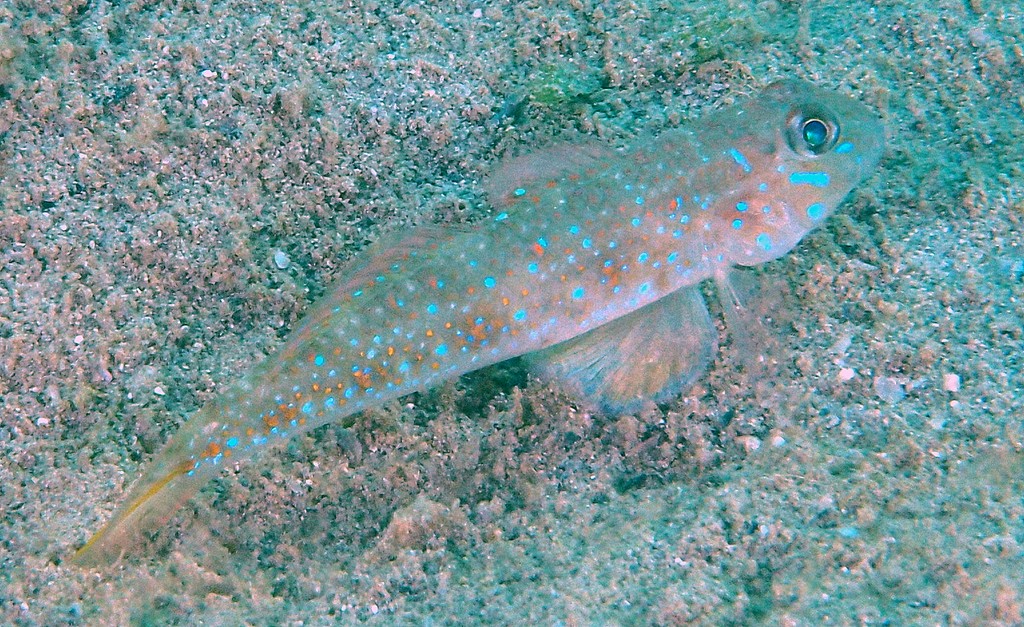OPLOPOMUS OPLOPOMUS - (VALENCIENNES, 1837)
Actinopterygii (Gigaclass) > Actinopteri (Class) > Teleostei (Subclass) > Gobiiformes (Order) > Gobioidei (Suborder) > Gobiidae (Family) > Gobiinae (Subfamily) > Oplopomus (Genus)
Gobie à préopercule armé, Pretty lagoon-goby, Spinecheek goby, Stekelwang-dikkop, Keshouhaze, ケショウハゼ, 刺盖鰕虎鱼,
Synonymes
Gobius bitelatus (Valenciennes, 1837)
Gobius bitelatus (Valenciennes, 1837)
Gobius notacanthus (Bleeker, 1858)
Gobius oplopomus (Valenciennes, 1837)
Hoplopomus acanthistius (Regan, 1908)
------------------------------------
Description
Dorsal spines (total): 7; Dorsal soft rays (total): 10; Anal spines: 1; Anal soft rays: 10; Longitudinal scale series: 29-30; Predorsal scales: about 13; Mainly ctenoid scales on body; Cycloid scales on prepectoral area, breast and abdomen; Preopercular margin just above angle with 1-3 small spines; depth of body: 4.0-4.6 in SL; Forth and fifth dorsal spines prolonged in male and may have filamentous tips; Strong and sharp tipped first spine of each dorsal fin; United pelvic fins, well developed frenum present; Rounded caudal fin, shorter than head length. Max. length: 10.0 cm TL. Depth range: 1 - 30 m, usually: 1 - 20 m.
Description
Dorsal spines (total): 7; Dorsal soft rays (total): 10; Anal spines: 1; Anal soft rays: 10; Longitudinal scale series: 29-30; Predorsal scales: about 13; Mainly ctenoid scales on body; Cycloid scales on prepectoral area, breast and abdomen; Preopercular margin just above angle with 1-3 small spines; depth of body: 4.0-4.6 in SL; Forth and fifth dorsal spines prolonged in male and may have filamentous tips; Strong and sharp tipped first spine of each dorsal fin; United pelvic fins, well developed frenum present; Rounded caudal fin, shorter than head length. Max. length: 10.0 cm TL. Depth range: 1 - 30 m, usually: 1 - 20 m.
Color
Males with more intense blue spots on the head and more colorful markings on fins than females; Subadults lack the blue and yellow spotting but have more black spots.
Etymology
Oplopomus: from ancient Greek, hóplon = sheild. Hoplites were citizen-soldiers of Ancient Greek city-states who were primarily armed with spears and shields. Hoplite soldiers utilized the phalanx formation to be effective in war with fewer soldiers + from Greek, poma, -atos = cover, operculum.
Biology
Inhabits silty bottoms of inner lagoons and bays. Solitary or in pairs. Also occurred in shallow to deep coastal sand and mud flats, usually on the sand near large depression with burrow in the middle.
Etymology
Oplopomus: from ancient Greek, hóplon = sheild. Hoplites were citizen-soldiers of Ancient Greek city-states who were primarily armed with spears and shields. Hoplite soldiers utilized the phalanx formation to be effective in war with fewer soldiers + from Greek, poma, -atos = cover, operculum.
Original description: Gobius oplopomus Valenciennes, 1837 - Type locality: Massawa, Eritrea, Red Sea.
Distribution
Red Sea, Indo-West Pacific: East Africa, Persian Gulf and Madagascar east to Marshall Islands and Society Islands, north to Ryukyu Islands and Taiwan, south to Queensland (Australia) and New Caledonia.
Distribution
Red Sea, Indo-West Pacific: East Africa, Persian Gulf and Madagascar east to Marshall Islands and Society Islands, north to Ryukyu Islands and Taiwan, south to Queensland (Australia) and New Caledonia.
Biology
Inhabits silty bottoms of inner lagoons and bays. Solitary or in pairs. Also occurred in shallow to deep coastal sand and mud flats, usually on the sand near large depression with burrow in the middle.
